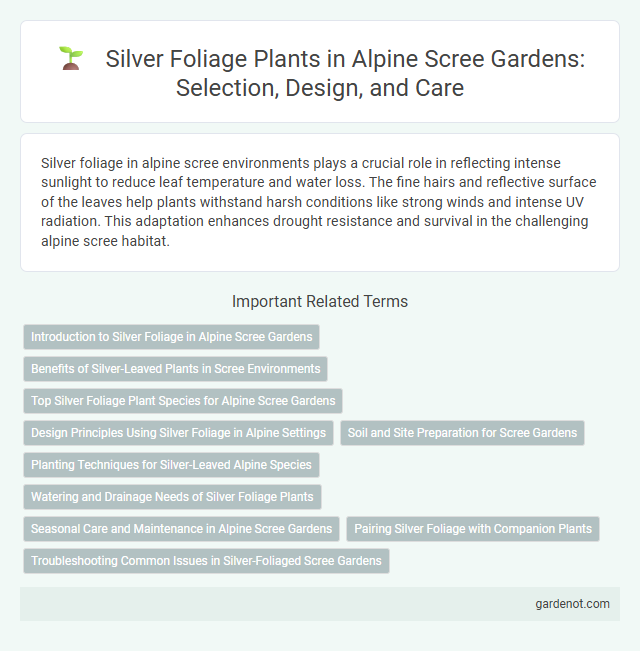Silver foliage in alpine scree environments plays a crucial role in reflecting intense sunlight to reduce leaf temperature and water loss. The fine hairs and reflective surface of the leaves help plants withstand harsh conditions like strong winds and intense UV radiation. This adaptation enhances drought resistance and survival in the challenging alpine scree habitat.
Introduction to Silver Foliage in Alpine Scree Gardens
Silver foliage, characterized by its unique reflective quality and fine hairs, enhances Alpine scree gardens by improving plant drought resistance and reducing water loss. This adaptation is common among species such as Artemisia, Senecio, and Cerastium, which thrive in alpine scree environments with intense sunlight and fluctuating temperatures. Incorporating silver-leaved plants in scree gardens not only adds textural contrast but also supports ecological resilience in harsh, well-drained soils.
Benefits of Silver-Leaved Plants in Scree Environments
Silver-leaved plants thrive in alpine scree by reflecting intense sunlight, reducing leaf temperature and water loss, which enhances their drought resistance. Their reflective foliage helps shield roots from extreme heat, promoting soil stability in rocky, nutrient-poor substrates. These adaptations support plant survival and biodiversity in harsh, high-altitude scree habitats.
Top Silver Foliage Plant Species for Alpine Scree Gardens
Top silver foliage plant species for alpine scree gardens include Artemisia schmidtiana, known for its fine, silvery leaves that thrive in well-drained, rocky soils. Saxifraga paniculata displays small rosettes with a frosted, silver-grey appearance adapted to harsh conditions. Another notable species, Helictotrichon sempervirens, offers blue-silver, tufted grass ideal for creating texture and color contrast in alpine scree landscapes.
Design Principles Using Silver Foliage in Alpine Settings
Silver foliage in alpine scree designs enhances visual contrast and texture, reflecting natural light to create dynamic depth in rugged landscapes. Incorporating plants with silver leaves, such as Artemisia and Saxifraga species, stabilizes soil while complementing rocky terrain with drought-resistant features. This approach balances aesthetic appeal with ecological adaptability, ensuring resilient and visually striking alpine garden compositions.
Soil and Site Preparation for Scree Gardens
Silver foliage plants in alpine scree gardens thrive best in well-drained, gritty soils that mimic their natural rocky habitats. Preparing the site involves incorporating coarse sand, gravel, and small stones to enhance drainage and prevent root rot. Ensuring a sunny, wind-exposed location with minimal organic matter supports healthy growth and maintains the characteristic silver sheen of the foliage.
Planting Techniques for Silver-Leaved Alpine Species
Silver-leaved alpine species thrive in well-drained, rocky soils typical of alpine scree environments, demanding precise planting techniques to mimic their native conditions. Planting involves placing specimens in gritty, mineral-rich substrates with excellent drainage to prevent root rot, often on south-facing slopes to maximize sunlight exposure and enhance foliar silver pigmentation. Careful spacing ensures adequate air circulation, reducing fungal risks and promoting the optimal reflection of sunlight by the silver foliage, which plays a vital role in temperature regulation and water retention.
Watering and Drainage Needs of Silver Foliage Plants
Silver foliage plants, commonly found in alpine scree environments, require well-draining soil to prevent root rot due to their sensitivity to excess moisture. Consistent but moderate watering is essential, ensuring the soil dries out between watering sessions to mimic natural alpine conditions. Proper drainage, often achieved through gritty, sandy substrates, supports healthy growth and maintains the foliage's characteristic silvery appearance.
Seasonal Care and Maintenance in Alpine Scree Gardens
Silver foliage in alpine scree gardens requires well-drained soil and minimal watering during dormant seasons to prevent root rot. Regular light pruning after flowering encourages compact growth and maintains its silvery appearance. Mulching with gravel helps regulate soil temperature and reduce moisture loss, essential for year-round plant health.
Pairing Silver Foliage with Companion Plants
Silver foliage plants like Artemisia and Lamb's Ear create a striking contrast when paired with vibrant blooms such as purple Salvia or bright yellow Coreopsis in alpine scree gardens. Their reflective, textured leaves enhance the color intensity and provide year-round interest and structure, complementing the rugged, well-drained soil conditions. Selecting drought-tolerant, low-growing companions ensures balanced growth and maintains the visual harmony characteristic of high-altitude scree landscapes.
Troubleshooting Common Issues in Silver-Foliaged Scree Gardens
Silver-foliaged plants in alpine scree gardens often face challenges such as chlorosis caused by nutrient deficiencies or poor drainage, which can lead to leaf discoloration and reduced vigor. Addressing soil pH and ensuring well-drained, gritty substrates with adequate micronutrients like iron and magnesium helps prevent these common issues. Regular monitoring for pests like aphids and fungal infections ensures early intervention, preserving the distinctive silver foliage characteristic of healthy scree plantings.
Silver foliage Infographic

 gardenot.com
gardenot.com